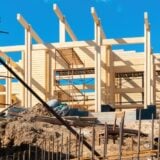The West maintained it’s the regional lead with yearly price growth of 19.5%, the HDI market report from real estate valuation firm Clear Capital shows.
But an analysis of rolling quarterly rates of growth indicate a moderation is underway. The index shows that national quarterly rates of growth have fallen from 3.8% to 2.1%.
Nationally, low price tier homes with values in the 25th percentile of all homes sold have seen strong moderation from the last rolling quarter. Current rolling quarterly gains of 2.5% are less than half of the prior rolling quarter. Considering this sector led the recovery, the current cooling is further indication that moderation is unfolding, according to Alex Villacorta, vice president of research and analytics at Clear Capital.
Of the 15 highest performing major metro markets, 11 have seen yearly gains top 20%. Lowest performing major metro markets remained relatively stable. Only one metro saw price declines over the last year at but with a fall of 1.1% Villacorta said this was a relatively minor decline.
Out of the top 50 major metro markets, the Detroit MSA turned out the strongest quarterly growth at 7.8% and second highest yearly gains of 31.6%. Villacorta said this can be attributed, in part, to its improved REO saturation rate, down 34.7% from the high of 64.6% in 2009.
Detroit’s median price is $120,000, just over half the national median price of $210,000. Relatively small price gains will more heavily influence percentage gains in Detroit than in higher priced markets, he explained. Detroit also ranks number one in REO Saturation at 29.9%.
Villacorta also said that in a market with severely depressed prices, bubble like behaviour is unlikely. A sustained recovery will depend on the strength of the local economy. Unemployment sits at more than 9% in Detroit, and median incomes are nearly half of national median incomes.
‘While prices across the country saw another boost in October, gains are starting to taper over the last quarter, in what could be the tail end of the summer buying season. We continue to see trends in the low tier price sector support a likely moderation ahead. And as we’ve maintained, moderation defines a healthy recovery,’ explained Villacorta.
‘While some markets currently have eye popping growth rates reminiscent of the housing run up, these trends are mainly short term corrections as markets fall back in line with their long run levels,’ he said.
‘While the speed at which some markets are returning to pre-bubble norms is noteworthy, recovery is relative. Detroit is a great example. While it has seen more than 30% growth over the year, the market would need to see another 262% growth to hit peak prices. Detroit prices have fallen in line with its historical trends (pre-2006). Following 2006, prices fell nearly 77%, so what we’re seeing is a response to a severe price correction,’ he added.





